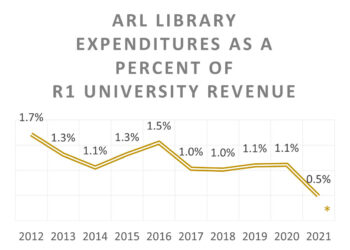
If God were an economist instead of a moralist, the first commandment he handed to Moses would most likely have been the Law of Unintended Consequences. It is a principle of extraordinary application; like God, it touches all corners of the universe. Among its virtues is its ability to foster humility and to ensnare idealists in its web.
This law may soon be manifested in all its majesty at the Office of Science and Technology Policy (OSTP), whose recent attempt to articulate a program for federally funded research aims to make the products of scientific research more widely available. The challenge for the OSTP is to reconcile its ambitions with God’s plan.
Before exploring some of the consequences of the OSTP’s new policy, I should note that there is no unanimity on this topic here at the Kitchen. My fellow chef David Crotty has argued with his usual eloquence that the new policy is even-handed and represents a serious effort to bring all parties together. Our colleague David Wojick notes that the plan, at least at this time, is terribly confusing and that compliance will be difficult. In the language of the proclamation I see something different, a note of weariness and exasperation as the administration is dragged into what is essentially a small affair when it has bigger problems to address. The policy makes no new funding available, proposes a set of guidelines to follow except when you don’t, presses for coordinated action without requiring it, and stipulates a period for embargo except when it does not apply. This is the kind of policy that strengthens Americans’ support for their government. For my part, I hear an echo of Jim, the fugitive slave in “Huckleberry Finn,” who has a little business on the side as a fortune-teller. Among his predictions: You’re gonna get sick, and you’re gonna get well. Yes, and the new OSTP program will make scientific research more widely available except when it does not. But the OSTP got it off their desk, and that was the objective.
To understand what the OSTP got wrong, we need a little primer on how publishing works. Now, before the vitriolic comments come flying, I am not saying how publishing should work or how it could work, but how it does work. The work of the publisher is to invest capital into intellectual property and then to exploit the hell out of it. There is in fact no such thing as a “journals publisher” or a “book publisher;” all investment takes place in an ur-property, the underlying IP that is manifested as a book, a journal, or something else. Publishing consists of investors who make item-by-item decisions on what properties to support, which ones to ignore. The people who guide this investment are called editors.
Once that investment has been made — in an article, a book, a journal, a database, all in their primordial form — it’s the job of someone else, who usually and confusingly bears the title of Publisher, to figure out how to make money from that investment. The publisher works with sales and marketing people, with the staff involved with licensing subsidiary rights (e.g., translations), and often with a business development group whose job it is to open up entirely new channels and markets for the company to enter. Crudely expressed, the job of all these people is to deliver a return on that initial investment.
Some observers of the journals world will mistakenly jump up at this time and say, Gotcha! There is no investment because publishers don’t pay authors or the reviewers. In fact the investment was made long ago at the time the publisher decided to create or acquire the journal. It can take five years or more to break even on a new journal. Journals publishing requires patient capital. It’s expensive to get into this business, even if you work only in digital formats, but potentially lucrative many years down the road. This is one of the two reasons Elsevier makes so much money: their size (the matter of scale; let’s call this the Coase Commandment), and the fact that they have been doing it for so long (the First Mover Advantage, something that Moses would have understood very well).
So now we that have this bit of IP, what do we do with it? The primary way research material is monetized is through the sale of library subscriptions or aggregations, though for some publications, libraries play a smaller role. It’s the library world that the OSTP is looking at when it suggests that research articles be made open access after an embargo period. The thinking is that the library revenue pays for the publication and libraries pay for things when they are published; so why should it matter to a publisher if something is made OA six or 12 months after publication since the libraries have already underwritten it?
Meanwhile, publishers are marketing the same IP in a multitude of packages. They make deals with companies like AcademicPub, Udini, DeepDyve, and SIPX; they seek translation rights income; they attempt to sell advertising; they sell coursepacks; they license databases for data-mining; and they aggregate articles into new journals organized by semantic category. The person who comes up with a new way to exploit IP in a publishing house is highly regarded. That person may rise to the level of Publisher or even CEO.
I was first introduced to this model metaphorically when I saw a billboard for a pork products company. There was a picture of a pink pig and the tag line: We sell everything but the squeal. Exactly.
Since research publishing is a media business, we should not be surprised to see this same principle at work in other media. Hollywood, which makes the biggest media investments of all, is the master of this game. Movies are made for first-run theaters, for international release, for cable TV. They are packaged and sold as DVDs, licensed to Netflix and HBO, and appear on network TV, where they are supported by consumer advertising. They spawn sequels and special collectors’ editions. Sometimes movies engender a “novelization” and movies for kids are famous for the merchandise they spawn. On some level, the folks at John Wiley and Springer are playing the same game as George Lucas.
So if you have a business with 10 income streams and one of them gets cut off, what do you do? You try to squeeze more revenue out of the other nine. If the 10 streams drop to five, you squeeze harder. It is the multiplicity of income streams that keeps prices down for any one manifestation of the underlying property. When in retreat, we husband our resources more carefully. We saw this play out just a few years ago during the world financial collapse. At that time a number of STM publishers that had previously made their publications available at no cost in developing economies changed their policies and began to charge for journals in countries such as India. Part of the reason for this was that they were attempting to offset the declines they were experiencing in troubled US and Western European markets.
What the OSTP regulations do (when they apply) is undermine some of those additional revenue streams, putting a greater burden on those that remain. The OSTP is not alone in this; the retrograde policy of OA after an embargo period is common now, and it is slowly and inexorably increasing the cost of materials to libraries. Why do OA activists hate libraries so much? I just don’t get it. (I wrote about the same problem as applied to books a couple years ago.) The OSTP will help to accelerate the migration from print to digital, resulting in sharp drops in advertising revenue; the policy cuts away at those publishers that sell individual articles; it essentially eliminates the sale of publishers’ backfiles; and it will shut down revenue from coursepacks. I wonder what it will do to the very large income streams from corporate accounts. Do corporate customers have the same need as an academic researcher to look at material within six or 12 months of publication? It will be interesting as well to learn of the OSTP’s policy on long-term preservation, now that no one has an economic incentive to keep materials in a safe and discoverable manner beyond the first year. Should libraries start ordering print editions once again to ensure preservation? Should they began a capital campaign to build new storage facilities?
The cancellation of subscriptions takes place at the margin — another Commandment to keep in mind. The most-used works do not get cancelled, but the more specialized publications do. As a library budget tightens (from cuts mandated by the administration, from price increases from suppliers, from the cost of completely new materials being offered for sale), something has to give, and what gives is a) the least important, and b) what can be found elsewhere. After the embargo period, more and more material can be found elsewhere.
None of this would be a problem if we continued to fund libraries richly, but those days are over. What is bizarre is that we keep coming up with new pressures on library budgets. This plays right into the hands of the largest publishers, as they are the best equipped to keep their programs with libraries in place — that is, the bigger entities continue to get bigger still, a principle known as the Law of Increasing Returns.
The implications of the OSTP’s outlook (assuming it applies to any particular case) are not apocalyptic. The current practices of peer review and dissemination will continue, though at a growing cost. Prices to libraries will nudge upward, but no one will attribute this to the OSTP. Smaller publishers will increasingly be marginalized, and the scientific societies that sponsor some of these publications will be challenged. To say that the OSTP is a cause of higher prices and more limited publications is not to say that it is a dramatic cause. It will be a cause slow to reveal itself.
It didn’t have to be this way. The OSTP could have done the sensible thing and simply insist that every government grant for research require that the author make a report on that research freely available, preferably in an open repository or network of repositories. There are problems with this strategy, as David Wojick has pointed out, but if it were properly administered, the taxpayers would have gotten exactly what they paid for, and with no embargo. This would be very disruptive to established publishers, but government research money is not designed for publishers to make a fat living.
What gets in the way of this proposal is the fact that, resent it though they do, OA advocates are aware that publishers add considerable value through the management of the system of editorial review. This is why the OSTP opted for what is essentially a Green policy over a Gold one, because it implicates the publishers without compensating them. It is a needlessly complicated policy with obvious stresses. Better that it were called Murphy’s Law and leave it to Moses to deal with.
Discussion
16 Thoughts on "The Law of Unintended Consequences Pays a Visit to the OSTP"
Well put Joe. Regarding the reports option you mention at the end, those reports exist for every grant and contract, and about half the funding agencies already make them freely available via the portal Science.gov, which I helped build. That OSTP chose to ignore this simple solution, going after published articles instead, is probably because OA is a political movement.
It is not really about giving taxpayers the research results they paid for; that is just a slogan. Making contract reports public is not revolutionary enough. They want to change the system in fundamental ways. If libraries get clobbered in the process well they are just part of the system.
I am not certain how you can make this hypothesis without acknowledging that the biggest financial stress on the journals model over the last decade has been the shift from individual subscriptions providing the overwhelming majority of the revenue to the exact opposite. This phenomenon is now effecting reference books in the same manner. The virtual disappearance of the individual purchaser from the market, combined with the individual expectation that the information professionals and students need to do their jobs is provided to them by the institution, is the single largest challenge for libraries in the current environment and is unsustainable without serious re-evaluation of library budget position. Talk about unintended consequences.
I agree with your description of publishing as a financial investment and would add that an intellectual investment (knowledge of subject matter and publishing skills) is also required.
I am not so sanguine about the comparison of scientific publishing with Hollywood. Movie makers aim for the lowest common denominator. Science publishers turn to the opposite fraction, a near custom market, outdone in narrowness only by customized reports of private consultants.
The weakness of the present policy is its blindness to researchers’ need for non-government research, a much larger body of knowledge than the product of US government grants. It is a pity that the much wiser approach embraced by Vannevar Bush after WWII, and expanded after Sputnik, has been swept away by petty competition for agency dollars.
Interesting Albert, but how can federal policy address non-government funded research?
“How can federal policy address non-government funded research?”
The answer, in the days of Sputnik, lay in the National Defense Education and Higher Education Acts, which helped library collections keep up with the growth in R&D publishing.
Today I puzzle how to motivate a politician who is more worried about the Tea Party than about the effectiveness of R&D dollars.
I like this perspective. I can’t argue with your definition of what we do. And, I don’t think there is anything wrong with that. It costs us a lot of produce a single article. Losing revenue streams is no laughing matter. It does need to be replaced, particularly for society publishers with mandates to publish member generated materials. The weak journals are supported by the strong. But the weak are still important, just not to as many people.
Upon my first reading of the OSTP memo, it felt like the White House said what it had to say and stopped short of thinking anything through. They checked the box and kicked the problem over to the agencies. I don’t see much evidence that the agencies are particularly concerned or excited about solving this problem. Maybe I am wrong about that. We will see what happens at the meeting next month at NAS.
OSTP has very litle authority over the agencies. It is basically a staff function while they are the line offices. (OMB has much more authority because they make the budget.) The vague flexibility in the OSTP memo reflects the fact that the inter-agency task force could not come to agreement on a policy. Different agencies want to do different things, including doing little or nothing. PubMed Central would like to become PubFed Central. How this will all play out is still far from clear. I doubt the agencies will reveal their plans next month in part because they do not have any at this point.
This seems to me the key statement in your post:
government research money is not designed for publishers to make a fat living
You are correct that this policy may interfere with some revenue streams for journals. In particular, I’d be very worried if I ran an aggregator service that republishes articles after an embargo period. Under this policy, a large chunk of inventory will now be freely available at the original source.
But ensuring a particular business model, or guaranteeing future profits based on current revenue streams is not the goal of a research funding agency. When the NIH funds a researcher to do experiments on a cancer pathway, the goal is to improve treatment for the disease, not to sell ads in a journal. There is confidence at funding agencies that increasing access to research results will accelerate the pursuit of those goals. It should probably be noted that this is something of an assumption, with little apparent documented study to support it.
Regardless, the publishing industry is at its heart a service industry. Our job is to meet the needs of our customers, that’s always been the challenge. Some journals do this better than others, that’s why some succeed and some fail. In this case, the customers need to satisfy the desires of their funders and we need to work out ways for that to happen. It would be nice to maintain business conditions forever, but markets change and businesses must adapt. If your journal can’t find a way to do this and thrive, someone else’s will.
Many of OUP’s science journals already make everything freely available after a year, as do many other journals from many other publishers. This was done in response to the NIH’s PMC policy, as we’d rather have researchers coming to the journal for access, and getting hold of the version of record than the PMC version. I can’t say that I’ve seen any signs of the widespread damage you propose, nor of the price inflation for libraries. You may be right and this may take more time to occur, but so far, so good.
I don’t think archiving is going to be affected here either. Archiving requirements are part of the policy. If a journal decides not to provide that service, it won’t be eligible for publishing funded work. Hence, there’s your incentive.
I do agree that like most of the OA movement (and the current state of funding and the economy in general), this will continue the drive toward market consolidation. The big publishers will continue to get bigger and the independents are going to get squeezed out of the market.
It’s also important to remember that “freely available” does not mean “free from copyright”.
“So if you have a business with 10 income streams and one of them gets cut off, what do you do? You try to squeeze more revenue out of the other nine.” And in another sector, textbook publishing, guess what the “untended consequence” of the Supreme Court’s recent decision in the case where Wiley lost is going to be? Very likely, textbook prices for students both in foreign countries like India and and in the U.S. will increase (because the foreign edition sales helped underwrite some of the costs of developing the textbooks). Nice move, Supremes!
Given that the alternative was a complete gutting of the First Sale doctrine, that speculative possibility seems to me like a relatively small price to pay.
Well, we read the law differently, for sure. My interpretation follows that of the American Bar Association, which submitted an amicus on the side of Wiley. http://www.americanbar.org/content/dam/aba/publications/supreme_court_preview/briefs/11-697_respondentamcuaba.authcheckdam.pdf
At this point, interpretation of the law is moot–the Supreme Court has spoken. What matters now is how the decision will affect the market. I suspect, like Sandy, that pricing structures are going to be adjusted, and prices in developing markets will be raised to make importing international editions less economically feasible. What’s been seen as a “win” for students may not turn out all that well for anyone.



